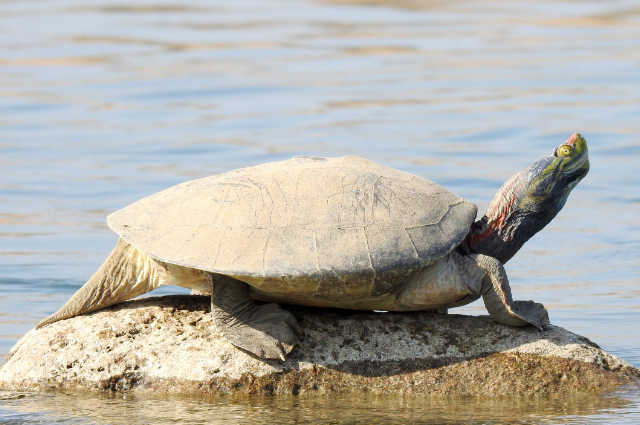In a significant stride towards rejuvenating the ecological health of the Ganga River, the critically endangered Red-Crowned Roofed Turtle has been reintroduced into its waters. This initiative is a key component of the government's flagship program aimed at cleaning the sacred river and boosting its biodiversity, signaling a renewed commitment to environmental restoration.
Strategic Release in Uttar Pradesh Wetland: A UNESCO Ramsar Site
Union Jal Shakti Minister C R Paatil announced through a post on X, that 20 of these rare turtles were released on April 26 in Uttar Pradesh's Haiderpur Wetland. This strategically chosen location is a UNESCO Ramsar site situated near the Bijnor Ganga Barrage within the protected Hastinapur Wildlife Sanctuary. This human-made wetland had formed in 1984 during the construction of the Madhya Ganga Barrage on the river's floodplain, provides a potentially suitable habitat for the turtles' re-establishment.
Believed to be on the edge of extinction in North India, the Red-Crowned Roofed Turtle's return to the Ganga is the result of a meticulously planned scientific rehabilitation endeavour, according to the minister. He hailed this reintroduction as a crucial milestone in the ongoing efforts to restore the Ganga River's delicate ecology. The ministry highlighted the alarming fact that there have been no confirmed detections of adult Red-Crowned Roofed turtles in the main channel of the Ganga for the past three decades that was underscoring the urgency of this intervention.
Tracking Progress: Technology Aids Reintegration
To maximize the chances of the reintroduction project's success each of the released turtles has been equipped with tracking devices. This technological measure will allow researchers to closely monitor their movement patterns and assess their progress in adapting to the Ganga's environment over time, providing valuable data for future conservation efforts.
A Tale of Two Release Strategies: Upstream vs. Downstream
Officials involved in the project implemented a dual-pronged release strategy. The reintroduced turtles were divided into two distinct groups: one released upstream of the Haiderpur Wetland barrage and the other downstream in the main channel of the Ganga. This comparative approach aims to determine which release method proves more effective for the long-term establishment of the turtle population in the river. The turtles will be under close observation and monitoring for the next two years to gauge the success of each strategy.
Pioneering a 'Soft' Approach: Aiding Gradual Adaptation
The Union ministry emphasized that this reintroduction marks the first attempt to re-establish this species in the Ganga using both 'soft' and 'hard' release strategies. The ultimate objective, with the crucial support of the Uttar Pradesh Forest Department, is to ensure the stable and sustainable presence of the Red-Crowned Roofed Turtle within the Ganga's ecosystem. Minister Paatil credited Prime Minister Narendra Modi's vision which took shape in the Namami Gange Mission as the driving force behind this significant turtle reintroduction initiative.
Years of Preparation: Assessing Habitat and Turtle Diversity
The groundwork for this reintroduction was laid through years of dedicated research and assessment. The Turtle Survival Alliance India project team with vital support from the National Mission for Clean Ganga (NMCG), conducted a comprehensive evaluation of turtle diversity and abundance within the Haiderpur Wetland Complex (HWC) in 2020. This was followed by a detailed Habitat Evaluation study in 2022, focusing on the newly established turtle sanctuary along the Ganga near Prayagraj in Uttar Pradesh.
A Stark Finding: The Rarity of the Red-Crowned Roofed Turtle
The studies conducted in the HWC suggested the presence of nine different turtle species, while indirect evidence pointed to five species in the Prayagraj region. However, a critical finding across the 2020, 2022, and prior studies was the complete absence of any viable populations or even individual sightings of the Red-Crowned Roofed Turtle in the surveyed stretches of the Ganga. This alarming discovery underscored its status as the most endangered turtle species in the entirety of North India, making its reintroduction a truly significant conservation endeavour.
A Species on the Brink: The Urgent Need for Intervention
The Red-Crowned Roofed Turtle, once a common sight across the vast Ganga and Brahmaputra river systems, now faces a dangerous existence in the wild. Its last known stronghold is the Chambal River, where alarmingly few individuals – believed to be less than 300 – remain. Recognizing the severity of its plight, the species is listed as "Critically Endangered" on the esteemed IUCN Red List and is also identified as one of the Top 50 Most Endangered Tortoises and Freshwater Turtles in Asia, underscoring the critical need for interventions like this reintroduction project.
Following Global Best Practices and Prioritizing Animal Welfare
Officials have affirmed that the reintroduction process strictly adhered to globally accepted translocation protocols by ensuring the well-being of the turtles at every stage. The release into the Ganga took place during the early hours of April 26, 2025. Conservation teams meticulously ensured that the animals were well-hydrated and stress-free throughout the process. Furthermore, transportation occurred during the night to shield the turtles from the potentially harmful effects of daytime heat exposure.
A Community United for Conservation: Beyond a Scientific Endeavor
Importantly, the reintroduction event transcended the realm of a purely scientific operation; it was also a vibrant celebration of community-led conservation. Local villagers, enthusiastic school students, and respected religious leaders (sadhus) gathered along the riverbank to witness the symbolic return of the turtles to the Ganga, highlighting the crucial role of community engagement in successful conservation efforts.
Officials are optimistic that this meticulously planned reintroduction effort will serve as a model for similar conservation projects across India. It is anticipated that this initiative will not only contribute significantly to the revival of the endangered Red-Crowned Roofed Turtle population but will also generate vital data and best practices applicable to the conservation of other threatened freshwater species facing similar challenges.
. . .
References:

